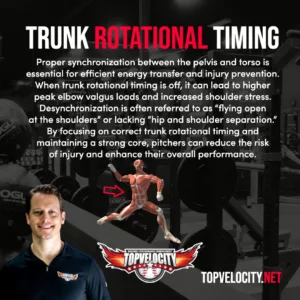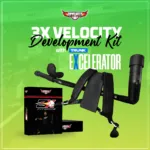In recent years, the significance of hip to shoulder separation in pitching has gained traction in the baseball world. This fundamental pitching mechanic, first highlighted by pitching coach Tom House, is now widely acknowledged for its effect on pitching performance, velocity, and even injury prevention. In this article, we'll delve deeply into the concept of hip to shoulder separation, its relationship to the kinetic chain, and how learning and mastering this technique can help you improve your pitching skills.
Numerous studies have found a strong correlation between high-velocity pitchers and their ability to attain greater hip to shoulder separation. When a pitcher can effectively transfer energy from their lower body, through their hips, and up to their shoulders while delaying the upper body, they accomplish this separation. As a result, the pitching action is more powerful, efficient, and stress-free, which not only improves performance but also lowers the risk of injury. We'll break down the mechanics of hip to shoulder separation, discuss the challenges of timing and power conversion, and look at how this technique can change you from an amateur or injured pitcher to a high-velocity, elite-level pitcher.
Here are some takeaways from this article on Hip and Shoulder Separation:
- Hip to shoulder separation is a fundamental pitching mechanic that enhances performance, increases velocity, and reduces injury risk.
- Mastering the kinetic chain involves understanding the role of leg drive and hip rotation in generating and transferring energy throughout the body.
- Proper timing and power conversion are essential for maximizing hip to shoulder separation and achieving a fluid, efficient pitching motion.
- Increased hip to shoulder separation leads to improved performance by effectively utilizing the kinetic chain and boosting pitching velocity.
- Focusing on hip to shoulder separation can help prevent injuries by reducing stress on the arm and promoting healthier body mechanics.
- Attending the 3X Velocity Camp provides expert guidance, personalized instruction, and hands-on training to master hip to shoulder separation and elevate your pitching performance.

Mastering the Kinetic Chain: How Your Legs Drive Hip to Shoulder Separation
In pitching, the kinetic chain refers to the sequential transfer of energy through different segments of the body—from the ground up. Mastering this chain is essential for maximizing hip to shoulder separation, which plays a critical role in both performance and injury prevention.
The legs initiate the chain by generating force against the ground. This energy travels through the hips, which must rotate aggressively while the upper torso remains closed. This dissociation—known as hip to shoulder separation—builds elastic energy that can be released explosively through the trunk and arm. According to Stodden et al. (2001), pitchers who exhibited higher pelvis rotational velocities during arm cocking and delayed trunk rotation achieved greater ball velocity, highlighting the importance of proper sequencing in the lower body.
However, generating leg drive alone isn’t sufficient. The conversion of linear force into rotational power must occur efficiently at the hips. This is facilitated by front foot opening and back leg drive, which contribute to rapid pelvic rotation while the torso remains counter-rotated. The separation between the two segments is what ultimately determines the magnitude of rotational velocity in the trunk.
Poor hip mobility or weak leg drive can break the chain early, limiting separation and increasing the stress placed on the arm. Research by Scher et al. (2010) supports this, showing that limited hip extension and internal rotation were significantly associated with a history of shoulder injuries in both pitchers and non-pitchers. These mobility deficits compromise the body's ability to properly segment and transfer energy, placing excessive loads on the throwing arm to compensate.
By improving lower body mechanics—particularly back-leg drive, front-foot bracing, and rotational sequencing—pitchers can establish the groundwork for greater hip to shoulder separation. This not only increases performance potential but also protects the arm from excessive loading.
Timing and Power Conversion: The Key to Maximizing Separation

While generating force from the lower body is critical, timing and power conversion are what determine whether that force results in elite-level pitching velocity or unnecessary strain on the arm. Maximizing hip to shoulder separation requires not only physical strength but also precise coordination between the lower and upper body.
During the stride phase, the hips should begin to rotate toward the target while the upper torso remains closed, counter-rotating against the hips. This delay—often referred to as trunk separation—is key to building rotational torque. Stodden et al. (2001) found that increased separation between pelvis and upper torso orientation at maximum external rotation of the throwing shoulder was strongly associated with higher ball velocities. This separation must be timed correctly during the arm cocking phase, when kinetic energy is stored in the trunk before being transferred to the arm.
In practical terms, this means the athlete must rotate the hips explosively while resisting premature torso rotation. If the shoulders open too early, the energy transfer is compromised, resulting in reduced velocity and increased arm stress. Werner et al. (2001) found that pitchers who demonstrated greater degrees of elbow flexion and shoulder external rotation at ball release experienced less shoulder distraction, suggesting more effective energy transfer from the trunk to the arm.
Achieving this synchronized delay requires both mobility and neuromuscular control. The front leg must stabilize quickly at foot strike, allowing the hips to rotate forcefully while the upper body stays closed. The glove side also plays a critical role, acting as a braking mechanism that helps anchor the upper trunk. Without these mechanics in place, the sequencing falls apart, and much of the energy generated by the legs fails to reach the throwing arm.
From a coaching perspective, this reinforces the need for drills that promote timing, sequencing, and hip-shoulder dissociation. Strength alone will not improve separation; pitchers must train their bodies to convert force into well-timed, rotational movement patterns that align with the throwing motion.
From Amateur to Elite: The Impact of Hip to Shoulder Separation on Performance and Injury Prevention
 Mastering hip to shoulder separation can change a pitcher's performance from that of an amateur or injured player to that of an elite, high-velocity athlete. Pitchers can increase their pitching velocity, optimize their body mechanics, and eventually elevate their game to new heights by successfully utilizing the kinetic chain and maximizing the separation between the hips and shoulders.
Mastering hip to shoulder separation can change a pitcher's performance from that of an amateur or injured player to that of an elite, high-velocity athlete. Pitchers can increase their pitching velocity, optimize their body mechanics, and eventually elevate their game to new heights by successfully utilizing the kinetic chain and maximizing the separation between the hips and shoulders.
Increased velocity results from efficient energy transfer through the kinetic chain, which is highly affected by the degree of hip to shoulder separation. Pitchers can better harness the energy produced by their legs by maximizing separation, resulting in faster pitches and improved overall performance. This improved efficiency improves the pitcher's effectiveness on the mound as well as their ability to endure the physical demands of high-level competition.
Focusing on hip to shoulder separation can improve performance while also lowering the chance of injury. Pitchers who can accomplish greater separation place less strain on their arms because the energy is distributed more effectively throughout the body. This reduction in arm stress reduces the chance of injuries like rotator cuff tears or elbow ligament damage, which are all too prevalent in baseball. Pitchers who have perfected hip to shoulder separation are frequently healthier and more durable throughout their careers.
Finally, the importance of hip to shoulder separation in pitcher effectiveness and injury prevention cannot be overstated. Pitchers can progress from amateur or injured players to elite, high-velocity athletes capable of contending at the highest level by mastering this basic pitching mechanic. Focusing on hip to shoulder separation not only improves performance, but it also adds to a healthier, more sustainable baseball career.
Achieve Pitching Greatness: Discover the Secrets of Hip to Shoulder Separation at the 3X Velocity Camp

Let me tell you something I’ve learned after working with thousands of pitchers—from high school hopefuls to pro-level athletes: the guys who master hip to shoulder separation are the ones who throw harder, last longer, and stay healthier. Period.
When I first started diving deep into the biomechanics of pitching, it became clear that the biggest velocity gains weren’t just coming from brute strength—they were coming from pitchers who could delay their trunk rotation just long enough to let the hips explode first. That separation between the hips and shoulders is the engine behind elite-level velocity.
And science backs this up. A foundational study by Stodden et al. (2001) showed that pitchers who achieved greater pelvis velocity and delayed trunk rotation during the arm cocking phase threw significantly harder. That’s what I see every day when we break down mechanics at the 3X Velocity Camp—when the hips go first and the torso stays closed, the ball jumps out of the hand.
But here’s what most people miss: separation isn’t just about throwing hard—it’s about staying healthy. If you’re not using the legs and trunk effectively, all that force has to go somewhere, and it usually ends up trashing the arm. According to research by Werner et al. (2001), pitchers who had better separation—shown by their elbow position and shoulder external rotation at release—experienced less shoulder distraction. That means less stress on the joint, more durability, and a longer career.
Even flexibility plays a role. A study by Scher et al. (2010) found that pitchers with poor hip extension and limited shoulder external rotation were more likely to suffer shoulder injuries. That tells us two things: (1) if your hips don’t move well, your shoulder is going to pay the price, and (2) working on mobility and strength across the entire kinetic chain is non-negotiable.
So if you're a pitcher stuck at 78–82 mph and wondering why your arm hurts after every outing, the answer might not be more long toss or more band work—it might be that you're not separating properly. When you train hip to shoulder separation the right way, not only does your velocity increase, but you also take pressure off your arm because you're finally using your body the way it was designed to move.
That’s why at TopVelocity, everything starts with separation. We don’t guess. We assess mechanics in detail, teach the kinetic chain from the ground up, and build durable velocity through biomechanics that work—not just drills that look good on Instagram.
You don’t need to be the biggest guy on the field to throw hard. You just need to learn how to move like one.





I need some pricing. And dates of availability hopefully on a weekend in November, Dec, and Jan. This is exactly what my soon to be 14 yr old son needs to learn.
Morning Mr. Fisher. I would be happy to help with that, can you give me a call at 985-315-3130, Thank you